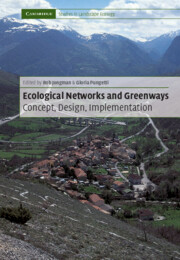Book contents
- Frontmatter
- Contents
- List of contributors
- Foreword
- Preface
- Acknowledgements
- 1 Introduction: ecological networks and greenways
- 2 The context and concept of ecological networks
- 3 Greenways in the USA: theory, trends and prospects
- 4 Ecological functioning of ecological networks: a species perspective
- 5 Impacts of roads on ecological networks and integration of conservation and transportation planning: Florida as a case study
- 6 Ecological corridors on a European scale: a typology and identification of target species
- 7 Planning the future landscape between nature and culture
- 8 From models to reality: design and implementation process
- 9 Design of the Pan-European Ecological Network: a national level attempt
- 10 Ecological ‘black spots’ within the ecological network: an improved design for rural road network amelioration
- 11 An ecological network for the Milan region based on focal species
- 12 Connecting corridors: implementing metropolitan greenway networks in North America
- 13 The Florida Statewide Greenways Project: its realisation and political context
- 14 The ecological network development in the Yungas, Argentina: planning, economic and social aspects
- 15 The river corridor of the Guadiamar
- 16 Conclusions: into the twenty-first century
- References
- Index
12 - Connecting corridors: implementing metropolitan greenway networks in North America
Published online by Cambridge University Press: 29 December 2009
- Frontmatter
- Contents
- List of contributors
- Foreword
- Preface
- Acknowledgements
- 1 Introduction: ecological networks and greenways
- 2 The context and concept of ecological networks
- 3 Greenways in the USA: theory, trends and prospects
- 4 Ecological functioning of ecological networks: a species perspective
- 5 Impacts of roads on ecological networks and integration of conservation and transportation planning: Florida as a case study
- 6 Ecological corridors on a European scale: a typology and identification of target species
- 7 Planning the future landscape between nature and culture
- 8 From models to reality: design and implementation process
- 9 Design of the Pan-European Ecological Network: a national level attempt
- 10 Ecological ‘black spots’ within the ecological network: an improved design for rural road network amelioration
- 11 An ecological network for the Milan region based on focal species
- 12 Connecting corridors: implementing metropolitan greenway networks in North America
- 13 The Florida Statewide Greenways Project: its realisation and political context
- 14 The ecological network development in the Yungas, Argentina: planning, economic and social aspects
- 15 The river corridor of the Guadiamar
- 16 Conclusions: into the twenty-first century
- References
- Index
Summary
Introduction
Greenways receive wide attention as landscape connectors for conservation, recreation, transportation, and neighbourhood enhancement. Hundreds of greenway projects are either complete or in progress in cities across North America; nearly all of the largest cities are planning for interconnected greenway networks (Grove 1990). Greenways are linear open spaces along natural or human-made features such as rivers, ridgelines, railroads, canals or roads. They are planned, designed and managed to connect and protect ecological, scenic, recreational and cultural resources. A greenway may include trails or it may be a conservation corridor without recreational access. Greenways have a number of other names (Ahern 1995; Cook and Van Lier 1994), each implying a slightly different focus, such as extensive open space systems, ecological networks, ecological infrastructure, wildlife corridors, or habitat networks.
Consider this scenario: a greenway network plan has been created for a metropolitan region. A number of entities have been involved in the effort, including the general public, governmental agencies, and non-governmental organisations. Given this, the greenways project still needs a structure in which to work – an organising method or institutional arrangement for implementation. Therefore, one main question frames this study: how have greenway projects been implemented in North American cities? This research focuses on interconnected greenway networks, rather than on individual corridors. (The term ‘network’ is used here to mean a meshed fabric of nodes and connecting corridors.)
‘We frequently perceive crises of governance where nothing seems to get done.’
Information
- Type
- Chapter
- Information
- Ecological Networks and GreenwaysConcept, Design, Implementation, pp. 200 - 221Publisher: Cambridge University PressPrint publication year: 2004
Accessibility standard: Unknown
Why this information is here
This section outlines the accessibility features of this content - including support for screen readers, full keyboard navigation and high-contrast display options. This may not be relevant for you.Accessibility Information
- 7
- Cited by
